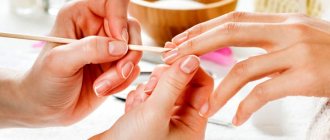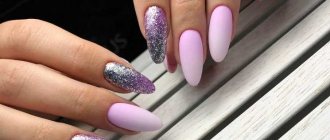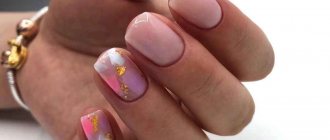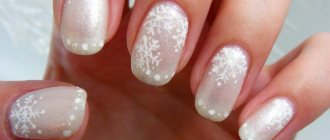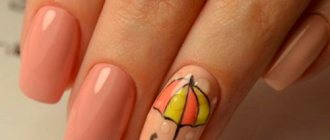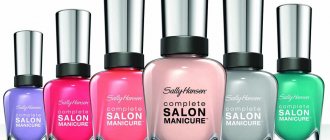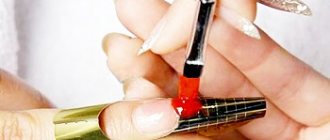What is hardware manicure
When performing a hardware manicure, it is important to know about the features of the procedure:
- To correct the cuticle and ridges of the nail bed, instead of a remover or tweezers, a special device with an attachment is used.
- Grinding the surface of the nail plate is carried out with the same apparatus using a different attachment.
- This technology is the most modern and does not require steaming the skin. The procedure is performed on a dry area of the nail bed.
- Using various attachments, the device allows you not only to polish your nails and skin, but also to change the shape of the nail plate.
- The hardware procedure is absolutely atraumatic, therefore it is best suited for delicate correction of nails after extensions.
Cutters for hardware manicure have a delicate effect, which is an advantage compared to edged manicure. The specialist uses attachments to remove keratinized particles of the cuticle and side ridges.
Healthy skin remains intact, which avoids bleeding and pain, as happens with cutting instruments. In the absence of damage, healthy skin remains smooth longer, eliminating the need for frequent correction.
The hardware manicure method is not suitable for everyone, and this is its disadvantage. If nails are in poor condition with dense cuticles and hard side ridges, cutters will not provide high-quality processing. In this case, the trimmed manicure will look neater.
How to choose cutters for home use
>Before you buy cutters for manicure, read the tips given by experienced nail service specialists:
- If you plan to do your own manicure with gel polish, then 4 basic attachments are enough. Among them: “cylinder”, “needle”, “cone” and grinding products;
- There is no need to spend money on expensive materials that are used for spraying, for example, ceramics. In addition to the high price, they are quite hard and can injure you. It’s better to stick with popular diamond coatings;
- special attention to the rigidity of the nozzles. Ideal option: white (grinding), red (cuticle), green (side rollers), blue (gel polish remover). But it’s better to forget about the black type. It is suitable exclusively for professionals;
- check the expiration date of the product. If it comes out, such a product is not worth buying;
- if the marked “T” sign is indicated, then the quality of the product is at a high level (titanium coating is present). The service life of such products is more than 3 years.
All products of interest can be purchased in the online store Royal-manicure.ru. In assortment:
- nozzles made of diamond, ceramic, corundum coating and carbide;
- large selection of grinding cutters;
- New – rubber base for caps. There are also metal products;
- sets of cutters (from 6 to 30 pieces).
You can also buy a special stand for cutters in the store. Thanks to it, all cutters will be kept clean. The cap reliably protects them from dust, dirt, and sunlight.
The choice of professionals
For nail technicians, there are suitable attachments that will help you get the job done not only efficiently, but also quickly:
Corn.
Removes artificial material from nails in a few seconds. It is better to choose a cutter with cross-shaped grooves. It is convenient to work with and is also suitable for cutting nails. A product with such a coating belongs to the professional category; beginners will definitely damage the nail plate. Minus - when working, the client may feel slight vibration and unpleasant sensations (tingling, burning).
Bullet.
Helps deal with ingrown toenails. Only the lateral parts of the fingers are treated with this nozzle. It is not suitable for working with cuticles.
Ball
You can get rid of cuticle remnants and sand the side ridges.
At the final stage, you need to start sanding your nails (if no artificial material is applied). It is better to use a silicone nozzle. It leaves a nice shine.
In addition to manicures, nail art specialists perform pedicures. For this process you will need the following types of products:
Round wide cone.
Suitable for rough skin, specialists treat the spaces between the fingers with it.
Inverted cone.
It will help to quickly remove rough areas and corns.
A cone ending in a ball.
Used in severe cases when the client has old core calluses. The master “drills” them out, not forgetting about proper disinfection before and after the procedure.
Experts advise not to purchase cutters in sets. From a financial point of view, this is beneficial, but from a practical point of view, it is an unjustified purchase. It is better to select nozzles individually (paying attention to material, type, hardness).
Milling machine
A milling machine is a device with a set of attachments - milling cutters. They can vary in power and rotation speed of the router.
The set of this device includes:
- Handle-micromotor.
- Control block.
- Pedal.
- Micromotor holders.
- Pen stand.
- Set of cutters.
- Case for cutters.
- Bag for the device.
When choosing a router, it is important to decide whether the device will be used at home or in a salon.
The home router has a number of features:
- Low power.
- The speed does not exceed 5000 rpm.
- Small size.
- A light weight.
This device is convenient for carrying out the procedure yourself.
For professional use, the device should be selected based on the following characteristics:
- The milling cutter must be fast and powerful.
- The speed should not be less than 30,000 rpm.
- It is important to have a built-in vacuum cleaner to collect sawdust.
- The ability to use the device not only for manicure, but also for pedicure.
- Eliminates overheating during long-term operation.
Without special skills, it is easy to damage your nails with a professional device. In such cases, you should choose a home router.
Don't miss the most popular article in the section: How to draw monograms on nails step by step for beginners. Instructions with photos.
Recommendations from professional craftsmen
To get a neat and attractive manicure, you need to choose a high-quality cutter. This can be done based on the recommendations of experienced professionals:
- First you need to decide what the cutter is needed for - to process arms or legs. The material of the tool depends on this, since each type of work requires certain characteristics.
- An equally important point is the place where the manicure cutter is used - at home or in a salon. For the salon, you need to purchase more cutters, and of high quality, since the tool will be used frequently.
- The product must be selected for a specific machine, since the power of all milling cutters is different, starting from 1500 rpm. The wear of nozzles depends on this indicator. At home, you can use the devices from the set without replacing them with new ones for a long time.
- The diameter of the nozzles also matters. Large devices are designed to work at low tool speeds, and small ones - at high speeds.
- Particular attention should be paid to the fact that some attachments may have the designation “T” - this means that the cutter is coated with a special compound to improve cutting properties.
Manicure and pedicure work requires treating the nail plate, cuticle and skin adjacent to the nail with different attachments. Using manicure cutters for purposes other than their intended purpose can lead to undesirable consequences such as damage to the nail plate, which can ruin not only the appearance of the nail, but also cause harm to health of varying severity.
Nozzles
Attachments for manicure performed using the device are not the same in size:
- Large attachments are useful for softening wide areas of skin covered with a thick, rough layer of dry particles. Most often they are necessary when performing a pedicure.
- Medium sized attachments can be used to treat the skin around the nail plate and ingrown toenails.
- Miniature nozzles are indispensable for precision work and processing sensitive skin. They can be used on brittle nails.
Types of cutters
Cutters for hardware manicure are divided into several types:
- Corundum cutters are made of synthetic ceramic chips, reminiscent of acrylic. They do not have sharp corners or edges, and the particle structure is not rigid. They gently remove sensitive skin. They leave no scratches behind. When interacting with corundum material, fabrics will not become peeling. This attachment is recommended for treating the side areas around the nails. Its service life is about 2 months.
- Diamond cutters contain diamond dust, making them the most accurate and versatile. They are suitable for medium to hard skin. Due to their high precision, they can be used in jobs that require precision. Diamond cutters are used for design, correction and extension of acrylic nails. This cutter will last up to 3 – 4 months.
This is what diamond cutters for hardware manicure look like - Ceramic cutters are suitable for delicate processing. The corundum particles included in their composition do not damage the skin. They have a self-regenerating effect and do not cause allergies. These cutters are suitable for processing pterygium and cuticle. The service life for them is about 2 months.
- Carbide cutters are traumatic, so they should not be used on natural nails. When working with artificial nails, they allow you to perform extensions, design and correction, as well as piercings and indentations for rhinestones. In the case of natural nails, they can only be used to remove ingrown toenails and calluses. Carbide cutters last from 4 months.
- Pomegranate cutters consist of garnet crumbs. They belong to a new generation and allow you to get the job done without damaging the skin. These cutters are recommended for novice cuticles for processing thin cuticles. They will last about 3 months.
- Silicon carbide cutters are made from rough materials, but are gentle on the skin. They can only be used on rough skin. It is recommended to remove calloused areas with these cutters. They can last about 6 months.
- Silicone cutters They are a mixture of silicone with abrasive particles. They are mainly used on extended nails. On natural nails, they can be used to remove the glossy layer before adding extensions. Such attachments last 4–5 months.
- Steel cutters are made from high quality alloys. They are convenient for removing the weakened layer of the nail, working on the nail plate and keratinized skin. With this device you can correct extended nails and eliminate callous formations. The service life is about 6 months.
Materials: comparison, pros and cons
The quality of the cutter depends on the material.
Ceramic
They contain corundum particles. They are very small, so this type of cutter is best suited for delicate tasks. They have a unique self-healing effect and are ideal for allergy sufferers without causing a negative reaction. Ideally, they treat the ptegirium and cuticles. On average, 1 ceramic nozzle lasts about 2 months.
Corundum
They are made from ceramic chips of a synthetic nature, a little like acrylic, resulting in a non-rigid structure of the nozzle, without corners and hard edges. They help gently remove sensitive skin without leaving scratches.
The material does not provoke tissue peeling and therefore with this attachment it is better to treat the side areas around the nail. It will last approximately 3 months.
Diamond
A universal variety due to the content of diamond dust. This attachment can be used on skin that has a high or medium level of hardness. If you need to carry out an operation that requires maximum precision, this precision cutter will be effective.
Work with acrylic nails (correction, design, extension) is carried out with attachments that last approximately 3-4 months.
Steel and carbide
Types of carbide manicure cutters are used on extended nails; for natural nails, such an attachment will be traumatic.
This is not the only function of such cutters, they:
- help make holes for rhinestones and piercings;
- effective against ingrown toenails and corns,
- last 4 months with active use.
Steel cutters are convenient for removing a weakened layer of the nail or working on hardened skin. The tools are made of high quality alloys; they correct extended nails and calluses well. They serve for six months.
Combined
Silicon carbide cutters seem rough at first glance due to the materials, but they are gentle on rough skin. They last approximately 6 months.
Silicone
This is silicone to which abrasive particles have been added. Usually not applicable on natural ones, only on extensions when you need to remove the glossy layer. Depending on the activity of use, they can last from 4 to 5 months.
Pomegranate
These products consist of pomegranate crumbs. Suitable for treating thin cuticles. The service life is 3 months.
Varieties of cutter shapes
According to their shape, cutters are divided into categories:
- Ball-shaped devices are required for delicate removal of excess skin. This form allows you to remove rough skin in hard-to-reach areas of the nail bed.
- Cylindrical cutters are used to correct the shape of the nail. Their narrowed body allows you to form nails of the same shape and length.
- Fissure cutters are indispensable when working with side rollers. They adapt to the skin texture, which allows you to get a smooth surface without peeling.
- Needle cutters are necessary for working with cuticles. They allow you to accurately perform precise work, working out small details.
Purpose of cylindrical nozzles
The same nozzle, even a convenient and universal one, cannot be used for all jobs at the same time. The purpose depends on the subspecies to which the cutter belongs - cylindrical, rounded, with a fairly soft surface, or a “drum”, with a hard, granular abrasive. The second option is used for areas that require effort during treatment - thick nails, rough skin. The “drum” cutter efficiently removes dead cells and grinds down hard areas. With its help, thickened nails are trimmed, adjusting the length and shape.
Cylindrical nozzles with a less rough, granular surface are used for:
- primary work on natural plates and free edges of nails;
- grinding and polishing the corners of the plate, rubbing oil and wax into it - you need to work with soft, delicate attachments (for example, corundum);
- removing artificial surfaces and uniformly reducing their thickness - as a rule, steel cutters with fine and medium cutting are used;
- processing the rollers on the sides of the nails - cutters with a rounded top and fine notches are convenient for this;
- work on hyperhidrotic, hyperkeratotic nails, thick coating - you will need a rough, preferably metal, cutter;
- creating designs on nails and so on.
Features of cylindrical cutters made of different materials
The “drum” and “cylinder” cutters differ in surface hardness and the material used to make the working part. The master selects tools based on the shape and roughness of the surface. The abrasiveness determines on what area the nozzle will be used (soft or rough) and what kind of work will be performed with it.
Steel and carbide tips are used to work with cuticles, keratinized nail ridges, and artificial nails. They differ not only in the abrasiveness of the working surface, but also in the type of notches. The purpose of the cutters depends on the “pattern”, which determines the location and type of cutting edges.
Classification of cutters by purpose
| Name of cutter | Purpose |
| Reverse cone | Necessary for processing the free edge of the nail. With its help, you can file your nails to the same length without leaving nicks or unevenness. This attachment helps to level the tip of the nail, smoothing out differences in height. |
| spherical bur | Designed for treating the skin around the nail. Thanks to its spherical shape, the nozzle allows you to trim off rough skin without affecting the nail plate. Indispensable for eliminating growths and cracks. |
| Cylindrical nozzle | Nozzles of this shape are thin and wide. They are used to remove gel polish and correct nail designs. In addition, they are most convenient for shortening the length of the free edge of the nail. |
| Drum | Allows you to remove calloused, rough skin. It can be used to trim thick nails. It is also used in hardware extensions. |
| Polisher | This nozzle resembles a rounded cone. It can be soft, medium or rough in terms of hardness. The tip is made of plastic or silicone with a polymer coating. Used to smooth out roughness on nails and add shine. |
Purpose of nail cutters
- Hardware manicure has proven itself from the best side. Among the advantages it is worth highlighting:
- can be performed both at home and in a beauty salon;
- nails look well-groomed and perfectly straight;
- minimal risk of skin damage. This virtually eliminates infections;
- The cutter speed is quite high, so the whole process takes up to 20 minutes.
To do a good job, you need high-quality cutters. They will help you do the following types of work:
- filing the plate;
- giving nails the shape you like;
- painless grinding;
- removal of excess skin and cuticle growths;
- correction of extended coverings (cutting, shaping, securing design elements);
- polishing
In addition, there are pedicure attachments. Their task:
- removal of cracked heels;
- removal of corns and calluses;
- foot skin treatment.
It is important! The key to the success of a high-quality hardware manicure is a high-power machine and correctly selected cutters (with the required coating).
Classification by hardness
The rigidity of the cutters is easily determined by the color designation. The color of hard cutters is always darker than that of delicate bits.
It is customary to distinguish cutters by shade:
- Black and blue highly abrasive attachments are used to treat rough and thick areas of skin, remove calluses, and also to shorten dense nail plates.
- Green and red medium abrasive attachments can be used to work on side rollers and medium-density nails.
- Yellow low abrasive nozzles are designed for thin, sensitive skin with nearby blood vessels. They are used to correct thin and brittle nails.
How to choose?
When choosing cutters yourself, it is important to take into account the opinion of professionals:
- It is necessary to decide on the purpose of the cutters. To perform exclusively hardware manicure, you should purchase the appropriate machine. Equipment for combined manicure and pedicure work is more expensive.
- You need to decide on the method of working with cutters. Individual work requires equipment of less power, which costs less. The speed of such a device does not exceed 5000 rpm. For salon use, you should choose powerful, expensive models.
- When choosing, you should evaluate the functionality of the device. The number of features affects the cost, but not all of them are useful. For example, built-in lighting is often unnecessary. But without the functions of protection against overheating and accidental switching on, the machine will quickly become unusable.
- The device should be easy to use. It is necessary to evaluate the weight of the device, its mobility and the length of the wire.
Cutters for hardware manicure determine the result of the procedure. Therefore, the device must meet all quality parameters.
How to choose cutters for hardware manicure
To select cutters for hardware manicure, it is recommended to proceed as follows:
- Decide: do you need cutters for hardware manicure or pedicure?
- For salon hardware manicure, cutters will need to be purchased in much larger quantities and of better quality. The device will be used much more often, and expensive consumables will last longer.
- Nozzles are selected for a specific device. The torque is different for everyone, the wear of the nozzles depends on the power of the device, which can produce revolutions of 1500 and above. When used at home, the cutter tips from the set included with the device can be used for a very long time.
- Preference should be given to milling cutters that provide protection against overheating of the cutter.
- The diameter of the nozzle is of no small importance. Small cutters should operate at high speeds, and large ones – at low speeds.
- Some types of attachments are marked with the letter “T”. This means that the product is coated with a substance that increases cutting ability.
The full list of properties of nozzles is determined by the ISO standard. To find out in more detail which cutters are used for hardware manicure, you can refer to this document. You should also know what the markings mean in order to have an idea of the properties of the nozzle.
There are different types of attachments for performing individual operations - treating the nail, nail plate, cuticle, and skin around the nail. It is important to understand what and why cutters are used in hardware manicure in order to achieve the desired result and not damage the nail.
Read the material on the topic: The most fashionable ideas for light manicure 2019
Top 5 indispensable attachments for beginning craftsmen
With all the variety of attachments for a router, it is impossible to make a hardware manicure without the following cutters:
- A cone-shaped or corn-shaped attachment for cuticles and ingrown nails is the basis of a manicure, because without it it is impossible to give a neat look to the work.
- Kidney-shaped attachment for the side surfaces of the nail. It cleans hard-to-reach areas of the nail bed.
- A cylinder will be needed to file nails to the same length, shape them, and create a design. It can be used to remove gel polish.
- The ball-shaped nozzle helps to remove calluses carefully and painlessly.
- A polishing attachment is necessary for polishing the surface of the nail.
How to insert a cutter into the machine
The method of inserting the cutter is determined by the type of clamp in the device.
Collet
They come in 3 types:
- The manual clamp opens at the touch of a button. After this, open the hole for the handle and insert it. Closing is carried out with the same button. This clamp is suitable for working at home.
- The semi-automatic clamp is activated by turning the handle attachment clockwise. After replacing the nozzle, turn the handles in the opposite direction until they click. This clamp is more convenient than a manual one. It can be used both in the salon and independently.
- With automatic clamping, you just need to insert the cutter. It will lock on its own. This technology is used in expensive devices for salon use.
Tips for using manicure machines at home
Cutters for hardware manicure for home use should be used according to the recommendations:
- It is necessary to use an antiseptic to ensure that the instruments and treatment area are sterile.
- Do not use devices with high rotation speed. This will help avoid injuries and cuts.
- To shorten the length, it is convenient to use disc cutters.
- Treatment of the cuticle and side ridges is carried out with movements from left to right.
- The cutter must be held parallel to the nail.
- When treating the sinuses of the nail, do not touch the nail plate.
- You can only work on the nail with polishing cutters.
Diamond nail cutters
The most popular are cutters made from diamond chips. The material refers to artificial turf. Such products are actively used during manicure and pedicure.
Their functions:
- removal of artificial turf;
- cuticle removal;
- processing of side rollers;
- fight against calluses and corns.
This type of product is ideal for working with sensitive skin and thin nail plates.
The cost of diamond cutters depends on the method of their manufacture:
- besieged. The crumb is simply glued to the metal base;
- sintered At the first stage, the crumbs are mixed with glue, after which they are applied to the blank and undergo heat treatment.
Experts recommend replacing diamond cutters every 3 months (with frequent use). During this time, the coating becomes thinner and becomes “clogged” with nail dust.
When purchasing diamond products, you need to pay attention to their abrasiveness (the ability of a cutter to grind down material characterizes its hardness).
For convenience, developers label their products. Even an amateur will be able to understand the intricacies of working with diamond bits:
- Black (super rough). The products are only suitable for working with artificial nails. Contact with skin (even rough) is prohibited. Otherwise, damage, burns, and wounds are possible.
- Green (rough). The attachments are ideal for manicure. Easily cope with corns and calluses. Also suitable for cutting extended nails.
- Blue (moderately rough). The crumb diameter is average. Can be used to remove cuticles. It is better for professionals to work with blue nozzles. Improper use will damage the integrity of the skin.
- Red (moderately soft). If the device has high power, you can use a red cutter to level the nail plate. But its main task remains the removal of the cuticle and side ridges.
- Yellow (soft). Particles are extra fine. Abrasiveness is kept to a minimum. May come into contact with skin and nails.
- White (super soft). Used for polishing and grinding only.
According to statistics, blue and red types of products can be considered the most popular cutters in terms of rigidity.
How to do a hardware manicure
The hardware manicure procedure is performed in several stages:
- Using a cylindrical cutter, you need to lift the cuticle and remove its excess, moving the nozzle in one direction. Do not press too hard on the nozzle to avoid damage.
- The diamond nozzle removes rough skin from the side rollers. Movements should be carried out smoothly, from one side to the other. Changing the reverse during operation is not allowed.
- A fissure cutter is used to clean the raised cuticle area and the lateral sinuses of the nail bed. This will help get rid of flaking and make the skin smooth.
- A corundum cutter is used to prepare the cuticle for cleaning and also to remove cracks.
- Using a bullet cutter, hard-to-reach areas in the lateral sinuses are processed. Do not use this attachment on the cuticle area. This will cause cuts.
- Using a ball-shaped cutter, the raised cuticle is removed. The movements should be pressing and then polishing.
- The procedure is completed by polishing the nails and shaping them with a cylindrical nozzle.
Don't miss the most popular article in the section: How to extend nails with gel polish. Nail extension instructions for beginners. Photo.
What cutters does a beginner need for home use?
The range of attachments for hardware manicure is huge. That is why it is so important for a novice specialist to know without which cutters it is impossible to complete the job.
We start with the preparation stage
Before you begin cleaning your nail bed, you need to do some prep work. To do this you need the following attachments:
Cylinder-drum. For beginners, it is better to opt for artificial turf. The material is softer, the risk of damaging the plate is minimized. This cutter will help remove artificial turf (gel, shellac, acrylic). Significant drawback: cutting speed is low.
Frustum. Helps to deal with the skin in the area of the side ridges, select and make the desired length of the nail. The nozzle has a gentle coating and does not cause wounds. The downside is that the cutter gets clogged quickly and you have to constantly clean it.
Corn with soft ceramic coating. Ideal for cutting extended material. The disadvantage is that it generates a lot of heat when using the product for a long time.
Advice from a professional! In order for cutters to serve you for a long time, they need to be stored in a dry place. It is better if a special protective cap is purchased for each nozzle.
Cuticle and pterygium removal
To remove excess skin build-up on and around your nails, you need separate attachments. They are softer, more gentle, and do not violate the integrity of tissues:
Needle. Outwardly it resembles a cone, only thinner and narrower. The main task is to remove the pterygium (thin film growing on the nail) and cuticle. In a classic manicure, this task is assigned to a cuticle pusher, a metal or wooden spatula. You need to use the attachment very carefully, the main thing is to work only with the skin, and not with the plate. To do this, the product must be held at an angle of 45 degrees and directed with the sharp end under the pterygium. This way the cuticle can be lifted without touching the nail.
Frustum. The size of this species is slightly larger than the Needle. Therefore, it is ideal for getting rid of cuticles.
"Pointed cone" Tidies up the side bolsters.
It is important! Beginners should not use products with natural coatings. Without the necessary skills, you will damage your nail.
The final stage. After your hands are in order, you need to give the nail plate some shine. This can be done using sanding attachments. Silicone, suede and felt cutters are in greatest demand.
How to sterilize cutters?
Manicure cutters should not contain residues of dirt, bacteria or infections.
Sterilization of hardware instruments occurs using specialized disinfecting solutions:
- Alaminol.
- Optimax.
- Gigasept.
- Blanidas.
- Korzolex.
These products are sold in concentrated form. To disinfect instruments, you need to prepare them. This is done by adding 3 tbsp. l. drug in 1 liter of cold, clean water.
When sterilizing cutters, it is important to consider the hardness of the material and the depth of the notches of the nozzle.
The soft coating will deteriorate after prolonged disinfection, so it is necessary to reduce the time. The average treatment time in the solution is 30 – 40 minutes.
After immersion in the solution, the cutters undergo the following processing stages:
- Cleaning under running water.
- Manual cleaning with a brass brush.
- Ultrasonic treatment.
- Immersion in dry heat or autoclave.
Features of care for cutters
Long service life of devices is impossible without proper care:
- When performing a manicure, do not forcefully squeeze the handle or put pressure on the nozzle. This will cause the head to bend at the base of the handle, rendering the cutter unusable.
- The nozzle must be changed according to the rules specified in the instructions for the specific device.
- After sterilization, cutters must be stored in a case that will protect them from moisture, dust and mechanical damage.
- The device must be promptly adjusted and cleaned at a service center.
Reviews
On the Internet there are mostly positive reviews about hardware manicure. Women note the speed of the procedure, as well as the comfort during its implementation.
A significant advantage is the durability of this type of manicure. Thanks to deep processing, correction is required no earlier than 2–3 weeks. Negative reviews are associated with contacting an unprofessional technician. In this case, cuts and unsatisfactory results are observed.
A professional hardware manicure cannot be performed without high-quality cutters. To select the best attachments, you need to study their varieties, rules of use and care.
Author: Alena Lash
Article design: Vladimir the Great

